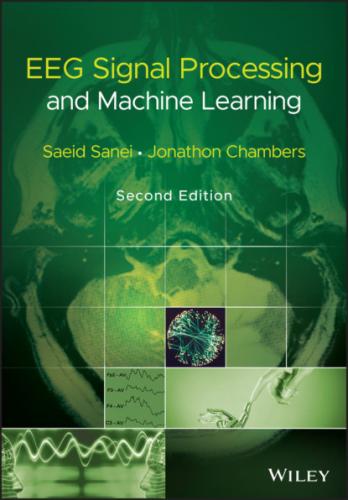16 Chapter 16Figure 16.1 Stimulus‐locked and response‐locked ERPs. Stimulus‐locked grand ...Figure 16.2 Typical faces and labels for congruent and incongruent stimuli u...Figure 16.3 Block diagram of the system developed in [55] for classification...Figure 16.4 Typical ERPs recorded (and averaged over trials) from the Fz ele...Figure 16.5 The mean asymmetry between the left and right brain hemisphere c...Figure 16.6 The 13 EEG electrode groups used in [74].
17 Chapter 17Figure 17.1 A cross‐section of the motor cortex and the links to different o...Figure 17.2 Readiness potential elicited around the finger movement time ins...Figure 17.3 The averaged RPs from C3 and C4 during left and right finger mov...Figure 17.4 ERD/ERS patterns over the central region (C3 and C4) during imag...Figure 17.5 A typical BCI system using scalp EEGs when visual feedback is us...Figure 17.6 A hybrid BSS‐SVM system for EEG artefact removal [98].Figure 17.7 Classification of left/right finger movements using space–time–f...Figure 17.8 Left finger imagination: two components. The upper figure repres...Figure 17.9 Right finger imagination: two components. The upper figures repr...Figure 17.10 The EEG signals before the removal of eye‐blinking artefacts in...Figure 17.11 Illustration of source propagation from the coherency spectrum ...Figure 17.12 Illustration of source propagation from the coherency spectrum ...Figure 17.13 A block diagram of the system proposed in [128] for classificat...Figure 17.14 The results of applying CSP to classify the cortical activity o...Figure 17.15 The electrodes highlighted in dark grey are those which are ove...Figure 17.16 A typical stimulus grid for the speller BCI.Figure 17.17 (a) The user operates the real‐time feedback loop to freely typ...Figure 17.18 The locations of the most popular neurotechnology products [157...
18 Chapter 18Figure 18.1 Block diagram of an MRI scanner illustrating the components invo...Figure 18.2 Gamma functions with varying parameters: (a) c changes from 0.2 ...Figure 18.3 The absorption coefficient curves for oxyhaemoglobin and deoxyha...Figure 18.4 The concept of cortex fNIRS imaging.Figure 18.5 The mechanism of inherent link between EEG and fMRI. (Top) An in...Figure 18.6 fMRI time series for a voxel sample.Figure 18.7 A schematic presentation of a GLM model for a sample fMRI time s...Figure 18.8 Gradient artefact for a sample segments of EEG signal recorded s...Figure 18.9 A set of 13‐channel EEG data covering the entire head, after gra...Figure 18.10 (a) Comparison between ICA and ICA‐DHT for BCG removal from EEG...Figure 18.11 Results of artefact removal from CZ channel using ICA (second f...Figure 18.12 A cycle of a BCG artefact in a sample segment of EEG signal.Figure 18.13 Topographic maps illustrating mu rhythm after the artefact is r...Figure 18.14 Simulated fMRI including the sources and corresponding time cou...Figure 18.15 Computed SIR of source of interest for different methods.Figure 18.16 Auditory data analysis results obtained from KL I‐divergence me...Figure 18.17 Visual data analysis results obtained from KL I‐divergence meth...Figure 18.18 Detected BOLD (top) with its corresponding time course (bottom)...Figure 18.19 Schematic of different steps of model‐based EEG–fMRI analysis....Figure 18.20 EEG electrode and fNIRS optode positions for imaginary movement...Figure 18.21 Example of a typical ‘BOLD’ response recorded by fNIRS in a tas...Figure 18.22 (a) Experimental setup and task procedure. The participant perf...
Guide
4 Preface to the Second Edition
5 Preface to the First Edition
9 Index
10 Wiley End User License Agreement
Pages
1 iii
2 iv
3 xvii
4 xviii
5 xix
6 xxi
7 xxii
8 xxiii
9 xxiv
10 xxv
11 xxvi
12 xxvii
13 xxviii
14 xxix
15 xxx
16 xxxi
17 xxxii
18 xxxiii
19 xxxiv
20 1
21 2
22 3
23 4
24 5
25 6
26 7
27 8
28
